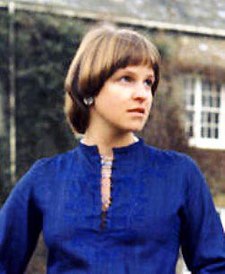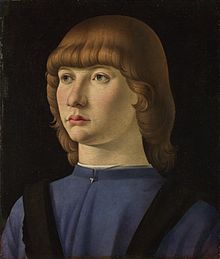Pageboy

Thepageboyorpage boyis ahairstylenamed after what was believed to be the haircut of a late medievalpage boy.It has straight hair hanging to below the ear, where it usually turns under. There is often afringe(bangs) in the front.[1]This style was popular in the mid-to-late 1970s and 1980s.
In popular culture[edit]
For women[edit]
In the early 1950s, theNew York Cityhairdresser M. Lewis popularized this style. SingerToni Tennilleof the 1970s pop duetCaptain & Tennillewore one as hersignature lookalong with 1976 Olympic champion and 1976 World champion figure skaterDorothy Hamill.In the Oscar-winning filmOne Flew Over the Cuckoo's Nest,the villainousNurse Ratchedis known for her pageboy. In theBuffy the Vampire Slayerepisode"Gone",Buffy has her hair cut into a pageboy. In the 1960s TV cartoonUnderdog,the show'sdamsel in distressSweet Polly Purebred (voiced byNorma MacMillan) has this hairstyle as hertrademark look.Mia WallaceinPulp Fictionalso sports a pageboy.AnnaSophia RobbasViolet BeauregardeandMissi Pyleas Violet's mother Scarlett Beauregarde in Tim Burton's film version ofCharlie and the Chocolate Factoryboth sport pageboys. In the 2003 TV seriesAll Grown Up!(a spin-off ofRugrats),Angelica Pickles(voiced byCheryl Chase) sports a pageboy.Velma Dinkley,of the variousScooby-Dooanimated series, has worn a short pageboy from her first appearance.Rei AyanamifromNeon Genesis Evangelionwears a shaggy pageboy. At the end of the Japanese anime seriesKill la Kill,Satsuki Kiryuin cuts her hair into a page style. InJohn Green's novelThe Fault in Our Stars,narrator and main character Hazel Grace Lancaster sports a pageboy haircut. The most prominent women to wear pageboys in the 1970s and 1980s were actressJoanna Lumleyas the character Purdey in television'sThe New Avengers,andDiana, Princess of Wales.In fact it was also known as the "Purdey Cut" and the "Lady Di" in the UK at the time.[citation needed]
For men[edit]

The pageboy was popular among men during theearly Renaissance.[2]
This haircut was also popular in the 1900s with young boys as it was first popularized by child actors, such asJohn Tanseyand, later,Jackie Coogan.The pageboy look on boys is often referred to as theDutch Boylook after the popular fictional character. The pageboy returned to male fashion in the 1960s for grown men with straight hair after getting popularized by British rock bands such asThe BeatlesandThe Rolling Stones.This was copied by many of the U.S. garage rock/punk bands, includingThe Chocolate Watchband,?and the Mysterians,The Monkeesand theCount Five.Andy Warholand several members ofThe Velvet Undergroundalso sported the androgynous haircut. The earlyRamoneshaircuts were elongated pageboys, also sported, though less long, by the male members ofBlondie.In the 1980s, the haircut became a symbol of garage punk and UK beat music as seen on the albumRockabilly Psychosis and the Garage Diseaseand worn by bands with 1960s influences, such asThe BarracudasandPrimal Scream.Mansunlead guitarist,Dominic Chad,was known for sporting this haircut in the late nineties.
Although it is currently a hairstyle worn far more by women, many men have worn it, including characters such asMowgliinDisney's 1967 version ofThe Jungle Book,Luke Skywalkerin 1977'sStar Wars: A New Hope,He-Manin his 1980s incarnation, Anton Chigurh inNo Country for Old Men,[3]and the eponymous star of the American comic stripPrince Valiant.The latter instance inspired the pageboy's sometime nickname of "the Prince Valiant" or "Prince Valiant cut". The character ofWilly Wonkaas played byJohnny Deppin the film version ofCharlie and the Chocolate Factorywore this hairstyle.
David McCallumwore the hairstyle in the 1975 TV seriesThe Invisible Man[4]and child actorAdam Richpopularized it for children in the seriesEight Is Enough,which ran from 1977 to 1981.
The hairstyle is also displayed by the brothers Anthony and Phillip Bonfiglio, on the animated seriesF Is for Family.
See also[edit]
References[edit]
- ^Jacobson, Judy (2001).A Field Guide for Genealogists - Judy Jacobson - Google Books.Genealogical Publishing Com.ISBN9780806350981.Retrieved2016-07-17.
- ^Hudson, Mark (2009).Titian: The Last Days.Walker & Co. p. 37.ISBN978-0802710765.
- ^Griggs, Brandon (March 1, 2018)."We rank all the Best Picture winners since 2000, best to worst".CNN.RetrievedMarch 1,2018.
...while Javier Bardem's Anton Chigurh, in a bizarre pageboy haircut, is the most indelible movie villain since Hannibal Lecter.
- ^"The Invisible Man TV Series, 1975".February 28, 2008.RetrievedMarch 5,2018.
External links[edit]
 Media related toPageboy haircutat Wikimedia Commons
Media related toPageboy haircutat Wikimedia Commons The dictionary definition ofpageboyat Wiktionary
The dictionary definition ofpageboyat Wiktionary
